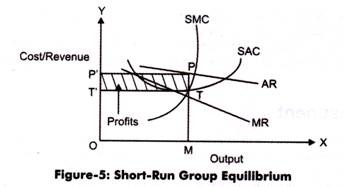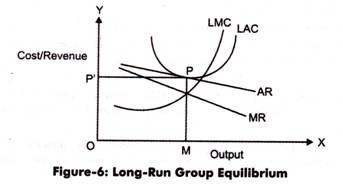i. He assumed that the demand and cost curves of all products forming the group are the same or uniform. This assumption is termed as uniformity assumption. According to this assumption, the preferences of consumers are evenly distributed and the difference in preferences is not that much to give rise to variation in cost.
ii. He also assumed that in monopolistic competition, a large number of sellers are not able to influence each other’s decisions. This implies that if an organization makes changes in prices or level of output, this would have insignificant influence on its competitors. Such type of an assumption is termed as symmetry assumption.
These two assumptions form the basis for group equilibrium analysis. If an organization within the group has established a popular brand, it is more likely to earn supernormal profits. However, in the long run, other organizations would strive to emulate the product design and features. In such a case, supernormal profits would vanish.
ADVERTISEMENTS:
This is a general case of all monopolistically competitive organizations. On the other hand, if the entire group is earning supernormal profits, then external organizations would get attracted toward the group, until the legal or economic barriers are imposed.
Figure-5 shows the short-run group equilibrium:
In Figure-5, P is the equilibrium point at which output is OM, price is MP, and average cost is MT. In such a case, marginal cost is equal to marginal revenue. Therefore, organizations are earning supernormal profits (P’PTT’). However, these supernormal profits disappear in the long run.
Figure-6 shows the long-run group equilibrium:
In Figure-6, it can be seen that the supernormal profits are disappeared. Figure-6 also depicts that average revenue (AR) is tangent to LAC, which implies that price is equal to average revenue. Marginal revenue gets equal to marginal cost at the output level of OM. This shows that in the long run, all organizations in the industry are making normal profits.

